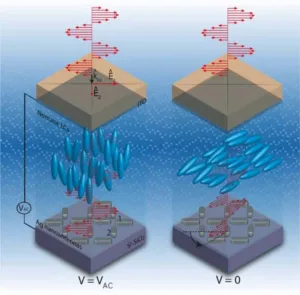A team of researchers at the Centre of Molecular Materials for Photonics and Electronics within the University of Cambridge (Cambridge, United Kingdom) is developing means to improve the performance of Liquid Crystal on Silicon (LCoS) spatial light modulators such as those used in a variety of holographic display systems. By this means, the goal is to improve the quality of the 3D image produced by such systems.
The latest work by the team is reported in an article entitled “Switchable holographic pixel elements for 3D displays” published in the July 8, 2015 edition of the SPIE Newsroom. The article is available on-line and can be found here.
A variety of current generation holographic display technologies are based on Spatial Light Modulators. The SLM is composed of reconfigurable elements that are used to diffract monochromatic light. By this means it is possible to produce the arbitrary field distributions that are called for by computer-generated holograms.
The state of the art in SLM technology is, however, such that it is not currently possible to achieve the pixel density needed to produce high quality holographic imagery.
The solution to this problem investigated by the researchers is to produce smaller and more functional dynamic pixel elements. To do this, multiple (at this time, two) digital holograms are integrated into the reflective backplane of each LCoS pixel. The physical manifestation of the holograms can be thought of as patterns of antennas. The patterning is done using standard CMOS-compatible fabrication techniques. The antennas are made from silver and are sensitive to both wavelength and polarization.
When illuminated with a specific wavelength of light, the antennae in each holographic pixel directionally re-radiate the incoming light. The radiation from the various antenna interfere producing specific output patterns in the far field. In the pixels developed by the team in which liquid crystal has been included, it is possible to electrically select which polarization of the illuminating light and, hence, which of the two holograms in each pixel is excited.
The figure below illustrates two images produced by a single pixel when illuminated with two orthogonal polarizations of monochromatic light. Note that the two images present slightly different perspectives of the same object.
One of the team members stated that “This unique design offers far greater control of the optical wave front from a single pixel. Rather than just modulating levels of gray, we can now modulate wavelength and polarization levels. For the case at hand, we could include extra information about the optical wave front in the display and access it electronically”.
The next steps in the team’s investigations will center on new designs intended to allow greater optical control and the integration of new thin-film materials. – Arthur Berman
Yunuen Montelongo, +44-1223-748365, ym283@cam.ac.uk
Timothy Wilkinson,+44-1223-748353, [email protected]

